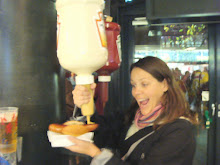 Before leaving for Prague I discovered that one of the possible out-of-town attractions that Kevin and I could visit was a crystal factory. Knowing that Kevin has had his fill of castles and museums, I thought a factory tour would be something that we would both enjoy. I wasn't able to figure out how to get there by public transportation, though, so we decided to take a tour instead.
Before leaving for Prague I discovered that one of the possible out-of-town attractions that Kevin and I could visit was a crystal factory. Knowing that Kevin has had his fill of castles and museums, I thought a factory tour would be something that we would both enjoy. I wasn't able to figure out how to get there by public transportation, though, so we decided to take a tour instead.The tour package included transportation from our hotel to the Rucki Crystal Factory in the town of Nizbor, about 45 minutes outside of the city. No searching for the train station or trying to discern the schedule was necessary. Since November is low season, we were luck to have a semi-private tour. There were only two other people in the group with us. On the way through the city, our guide spoke about the points of interest that we passed and provided us with a bit of history as we traveled along the highway.
 The area around Prague is world-famous for it's Bohemian cut crystal, which was first produced in the region in the early 17th century. Glasscutters from Italy and Germany traveled to Bohemia and cut the natural crystal found in the mountains of the region. In the 18th century manufactures began producing cut chalk-glass items. These products brought the Czechs fame, but they fell out of fashion by the early 19th century. Soon, however, the manufactures turned to making lead crystal. And by the middle of the 19th century, the region was again at the top of the industry.
The area around Prague is world-famous for it's Bohemian cut crystal, which was first produced in the region in the early 17th century. Glasscutters from Italy and Germany traveled to Bohemia and cut the natural crystal found in the mountains of the region. In the 18th century manufactures began producing cut chalk-glass items. These products brought the Czechs fame, but they fell out of fashion by the early 19th century. Soon, however, the manufactures turned to making lead crystal. And by the middle of the 19th century, the region was again at the top of the industry.Once we arrived at the factory we switched tour guides. The new guide, who worked for the factory, gave us a brief overview of the family that ran the business and the materials used for production. This factory makes most of its products on an order-by-order basis, which is why the name isn't as well known as other manufactures. Then she took us to see the glass being blown.
 It was amazing to see the glowing masses removed from the furnace, and then blown. I kept thinking that it was like bubbles for adults. One thing that shocked and surprised me is that the glass blowers are allow to drink beer and smoke cigarettes while at work. The factory even provides the brew. Our tour guide assured us, though, that it had a very low alcohol content.
It was amazing to see the glowing masses removed from the furnace, and then blown. I kept thinking that it was like bubbles for adults. One thing that shocked and surprised me is that the glass blowers are allow to drink beer and smoke cigarettes while at work. The factory even provides the brew. Our tour guide assured us, though, that it had a very low alcohol content.After watching the glass being blown, we saw the quality control department in action. Less than 20 percent of all glass blown makes the cut. The rejected pieces are then tossed into large bins, which are then sent back to the furnace. Nothing in the factory is wasted.
The items that are approved are then sent to the cutting room. Workers here sit at diamond-saw wheels for eight-hour shifts. Each day they work on one part of one design. Repeating the cuts over and over again.
After walking through the factory I have a whole new appreciation for cut crystal.





No comments:
Post a Comment